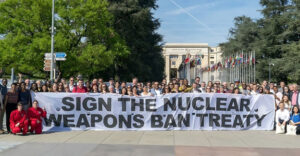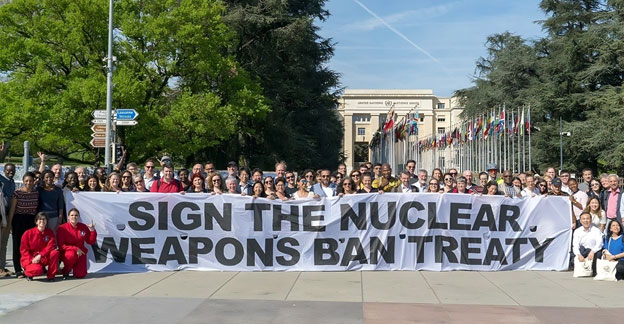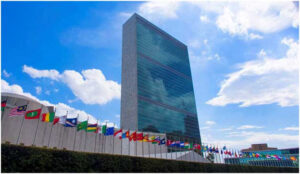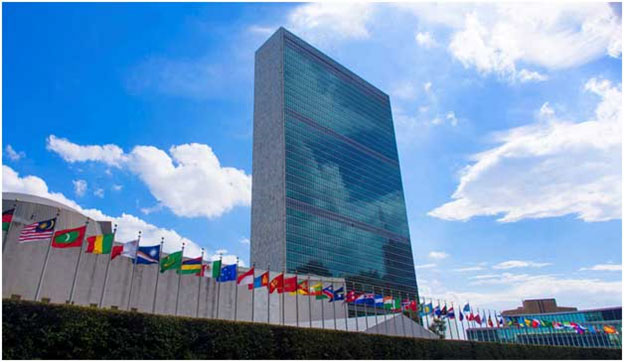
Civil Society, Featured, Global, Global Governance, Headlines, Human Rights, International Justice, IPS UN: Inside the Glasshouse, TerraViva United Nations

The International Campaign to Abolish Nuclear Weapons (ICAN) is a coalition of non-governmental organizations (NGOs) in over 100 countries promoting adherence to, and implementation of, the United Nations nuclear weapons ban treaty. Credit: ICAN
– When the high-level meeting of over 150 world political leaders takes place September 22-30, thousands of non-governmental organizations (NGOs) and their accredited UN representatives will either be banned from the UN premises or permitted into the building on a strictly restricted basis– as it happens every year.
This year will not be an exception to the rule.
In a message to staffers, journalists and NGOs last week—spelling out the rigid ground rules during the summit– the UN said members of civil society organizations (CSOs) and NGOs who are invited to attend high-level meetings or other events will be required to be in possession of a valid NGO pass– and a special event ticket (indicating a specific meeting, date and time) at all times to access the premises.
“A United Nations non-governmental organization (NGO) pass alone does not grant access during the week of 22–30 September 2025”, the message warned
These restrictions have continued despite the significant role played by NGOs both at the UN and worldwide.
A former UN Secretary-General, the late Kofi Annan (1997-2006), once characterized NGOs as ”the world’s third superpower.”
And a former Deputy Secretary-General Asha-Rose Migiro (2007-2012) told delegates at a UN meeting, the United Nations relies on its partnership with the NGO community “in virtually everything the world body does”.
“Whether it is peace-building in sub-Saharan Africa or human rights in Latin America, disaster assistance in the Caribbean or de-mining efforts in the Middle East, the United Nations depends upon the advocacy skills, creative resources and grass-roots reach of civil society organizations in all our work,” she said, paying a compliment to NGOs.
The NGOs playing a significant role in humanitarian assistance include Oxfam, CARE International, Doctors Without Borders, International Committee of the Red Cross, the Red Crescent, Save the Children, Action Against Hunger, among others,
During an event marking the 75th anniversary of the UN Charter in 2020, the current Secretary-General, Antonio Guterres, said civil society groups were a vital voice at the San Francisco Conference (where the UN was inaugurated 80 years ago).
“You have been with us across the decades, in refugee camps, in conference rooms, and in mobilizing communities in streets and town squares across the world.”
“You are with us today as we face the COVID-19 pandemic. You are our allies in upholding human rights and battling racism. You are indispensable partners in forging peace, pushing for climate action, advancing gender equality, delivering life-saving humanitarian aid and controlling the spread of deadly weapons”.
“And the world’s framework for shared progress, the Sustainable Development Goals, is unthinkable without you”, he declared.
But none of these platitudes have changed a longstanding UN policy of restricting NGO access to the UN during high-level meetings.
The annual ritual where civil society members are treated as political and social outcasts has always triggered strong protests. The United Nations justifies the restriction primarily for “security reasons”.
Currently there are over 6,400 NGOs in active consultative status with the UN Economic and Social Council (ECOSOC).
https://social.desa.un.org/issues/disability/cosp/list-of-non-governmental-organization-accredited-to-the-conference-of-states
Mandeep S. Tiwana, Secretary General, CIVICUS, a global alliance of civil society organizations, told IPS: “It’s really disappointing to see how year on year, civil society representatives who help the UN achieve its mandate, share its values and provide vital entry points to peoples’ needs and aspirations, are systemically excluded from the UN’s premises during UNGA week despite possessing valid annual security passes that are thoroughly vetted.”
Such blanket prohibitions on civil society representatives’ entry to the UN when momentous decisions and contentious debates are taking place are a missed opportunity to engage decision makers, he said.
“Such asymmetries in participation are the reason why many of us have been pushing for the appointment of a civil society envoy at the UN to enable better and more systemic involvement of civil society at the UN, ensure consistent engagement modalities across the UN system and drive the UN’s outreach to people around the world”.
“Despite, the UN Charter beginning with the words, ‘We the Peoples’, our call has fallen on deaf ears. It is well within the UN Secretary General’s power to appoint a civil society envoy that could be a legacy achievement, if realized,“ declared Tiwana.
Mads Christensen, Executive Director, Greenpeace International, told IPS: “We continue to believe in the UN and multilateralism as essential to achieving a green and peaceful future. Those in frontline communities and small island states most impacted by climate change must have their voices heard, as must young people whose very future is being decided. “
“We the peoples”, the opening words of the UN Charter, must not be reduced to “stakeholders consulted.” Civil society needs to be “in the room where it happens,” said Christensen.
Sanam B. Anderlini, Founder of the International Civil Society Action Network (ICAN), told IPS: “I find the exclusion or NGOs from UNGA ironic and tragic.”
Globally, she pointed out, “ We have raised the alarm bells about conflict, human rights abuses, the desecration of international law. Our sector is also the strongest of supporters for the UN system itself.”
“We believe in the power and potential of multilateralism, and the need for a robust UN that adheres to the principles of peace and human security. Yet the system does not stand with us. “
Today more than ever, she argued, civil society globally is under pressure, politically, financially, systematically. “Yet we still persist with doing ‘what we can’ to address societal needs – as first responders to humanitarian crises, mitigating violence”.
As the powerful abrogate their responsibilities, the least powerful are taking on that responsibility to protect.
The UN should be embracing and enabling this sector’s participation at UNGA. Just as civil society is a champion of the UN, the UN should be a champion of civil society. Yet it seems that ‘We the People of the United Nations’ are not only being marginalized but over-securitized. How many security checks, how many grounds passes does each person need?, she asked.
“How tragic that those of us advocating for peace and justice are outside of the halls of power, while those waging wars, enabling genocide and trampling international laws are inside”.
“But we will be there. If our voices are absent within the UN, that absence itself will speak louder than any words”, she declared.
Andreas Bummel, Executive Director, Democracy Without Borders, told IPS: “The UN should resist efforts by authoritarian states to delegitimize and shut out affiliated civil society groups.”
As the organization is under dramatic pressure to implement cost-cutting reforms, seen in the UN80 initiative, he said, it really needs to seek stronger engagement with civil society, citizens, and the public at large, not less.
Not admitting NGO representatives during the UNGA general debate is another lost opportunity to make a mark, declared Bummel.
IPS UN Bureau Report










